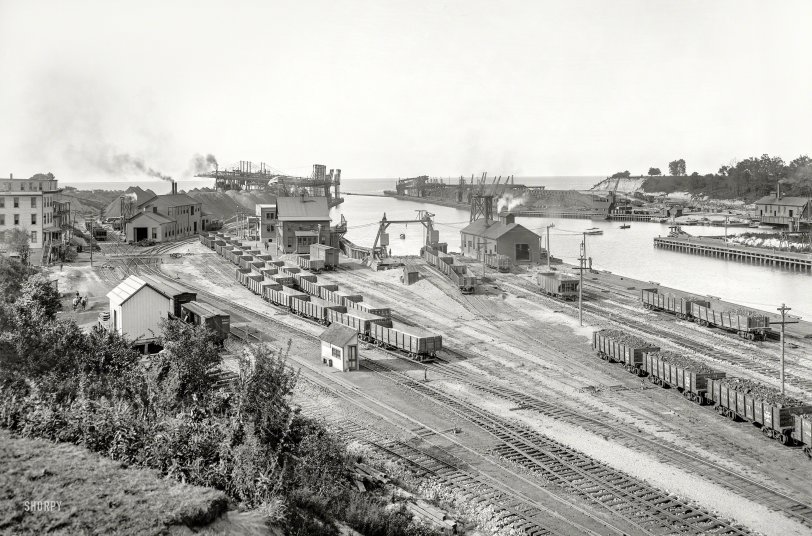


Framed or unframed, desk size to sofa size, printed by us in Arizona and Alabama since 2007. Explore now.
Shorpy is funded by you. Patreon contributors get an ad-free experience.
Learn more.

- Baldwin 62303
- Baldwin VO-1000
- Cold
- No expense spared
- Tough Guys
- Lost in Toyland
- And without gloves
- If I were a blindfolded time traveler
- Smoke Consumer Also Cooks
- Oh that stove!
- Possibly still there?
- What?!?
- $100 Reward
- Freeze Frame
- Texas Flyer wanted
- Just a Year Too Soon
- WWII -- Replacing men with women at the railroad crossing.
- Yes, Icing
- You kids drive me nuts!
- NOT An Easy Job
- I wonder
- Just add window boxes
- Icing Platform?
- Indiana Harbor Belt abides
- Freezing haze
- Corrections (for those who care)
- C&NW at Nelson
- Fallen Flags
- A dangerous job made worse
- Water Stop
Print Emporium
Industrial Tableau: 1900

Lake Erie circa 1900. "Harbor entrance at Conneaut, Ohio." Where ore from the Lake Superior iron ranges was unloaded for transport by rail to the smelting furnaces of Ohio and Pennsylvania. 8x10 inch glass negative. View full size.
The first Hulett unloader constructed
was at Conneaut in 1899, and can be seen in the very middle of the photograph, above the carferry slip of the United States & Ontario Navigation Company, the carferries of which, Shenango No. 1 and Shenango No. 2, brought railcars of coal crosslake to Port Dover, Ontario. Conneaut hosted another carferry service, the Marquette & Bessemer Dock & Navigation Company, which ran the Marquette and Bessemer No.1 and No. 2 (the former a collier which loaded coal directly from cars into its hold) to Erieau and Port Stanley. The first Marquette and Bessemer No. 2 disappeared with all hands on December 9, 1909, and the wreck has never been located.
Re: Track Scale
Nice description of the scale system!
So, was there enough freedom in the couplers to allow the locomotive to divert to the dead tracks and pull the loaded car through? Beats having to uncouple and drop the car, then pick it back up...
RR Car Track Scale
The building in the foreground with the steeply-slanted shed roof is a Scale House for weighing RR cars.
The tracks in front have two pairs of rails. You will see two sets of track switch points, but no switch frogs.
One pair is the "dead rails" - non-moving rails for the locomotive to traverse without crushing the scale.
The other pair are the "live rails" - cars on these rails are going over the scale platform.
In those days, the scale was a mechanical marvel that worked much like the balance scale in a doctor's office. Some had huge read-out dials, but many were moving counterweights on beams. The concept might be simple, but making this work accurately on something as heavy as a loaded RR car was no mean feat of design.
The pier in the far right background has what might be Hulett unloaders. These were featured on Shorpy not long ago.
Once again, a photo rich in satisfying detail and excellently composed and exposed.
Love my puzzles.
If any photo would make the perfect jigsaw puzzle, this is it.
That smoke looks real
Looks like a very well made model train layout.
2 Way Traffic
As shown by the railroad ferry slip in the center, and the loaded United States - Ontario Steam Navigation Co. coal cars waiting for the boat, the port was also used for Northbound traffic across Lake Erie to Canada.
Switchman's nightmare
Look at all the switches in these tracks. It must have been a nightmare for the switchman. Or did a worker walk alongside and change the switches as needed?
Conneaut?
Looks like a poor man's Ashtabula. Nice photo.
The other end of the trail
We saw the Marquette, Michigan docks where they load the boats with ore a few years ago on Shorpy. (Yes, they are called boats on the Great Lakes, even if they're 1,000 feet long).
























On Shorpy:
Today’s Top 5